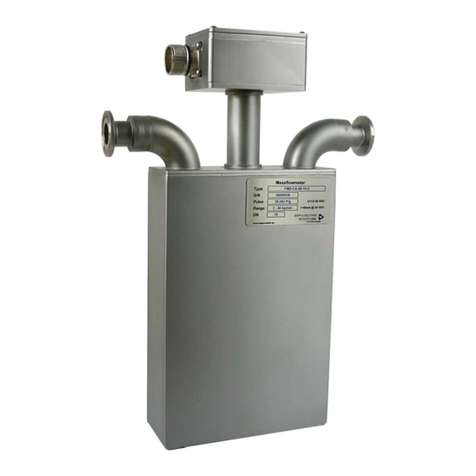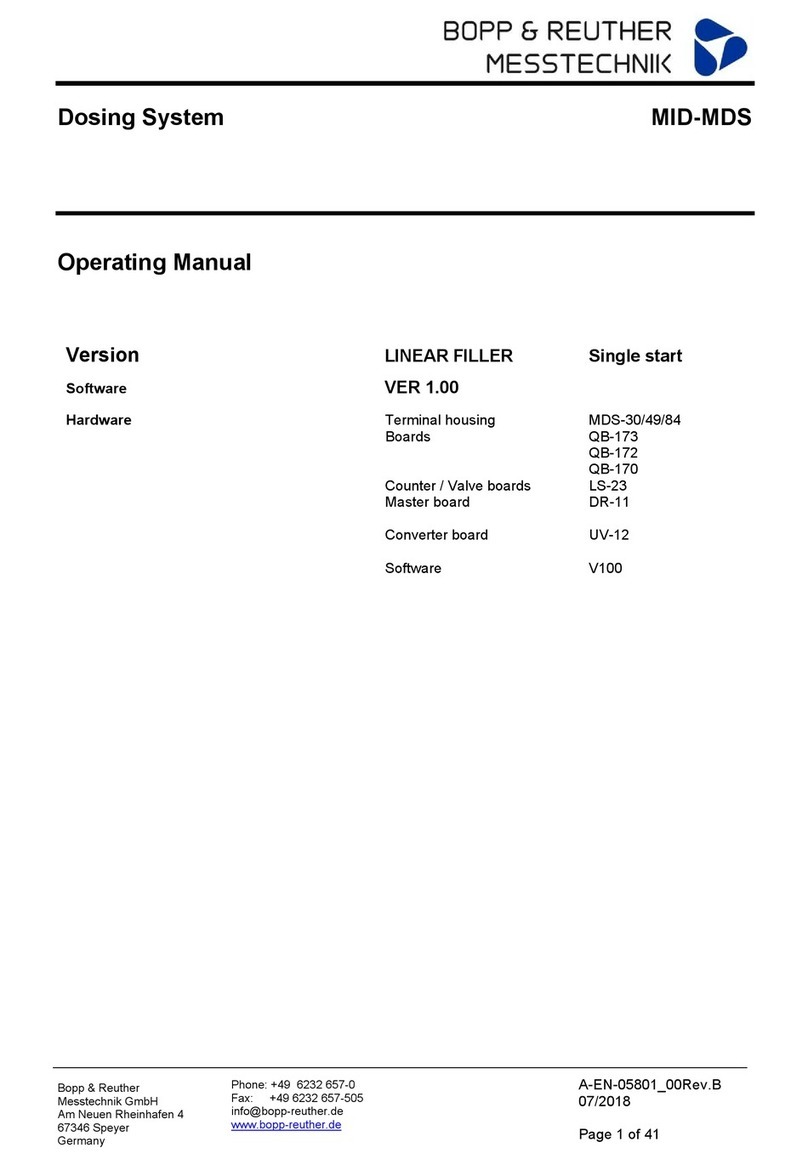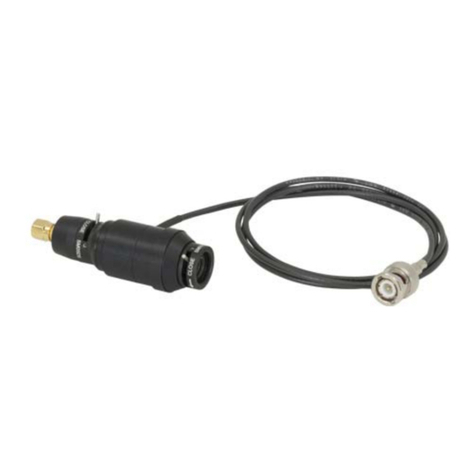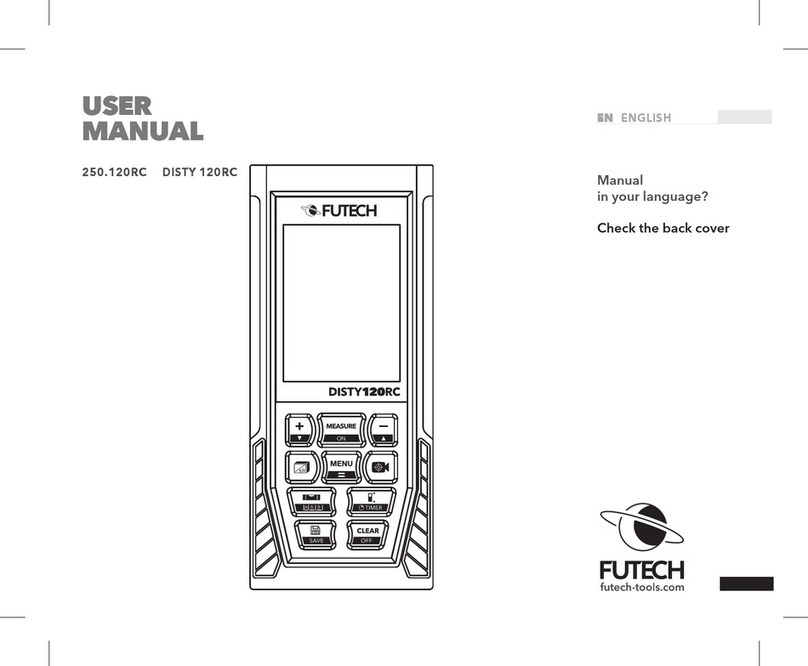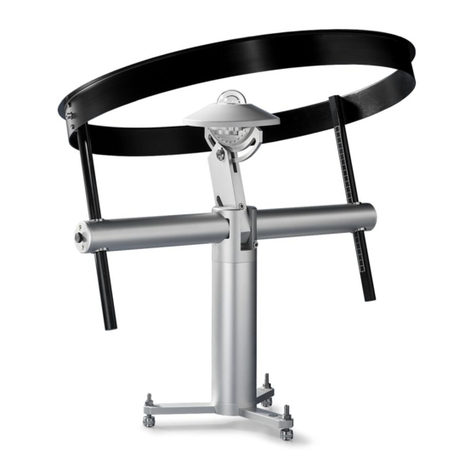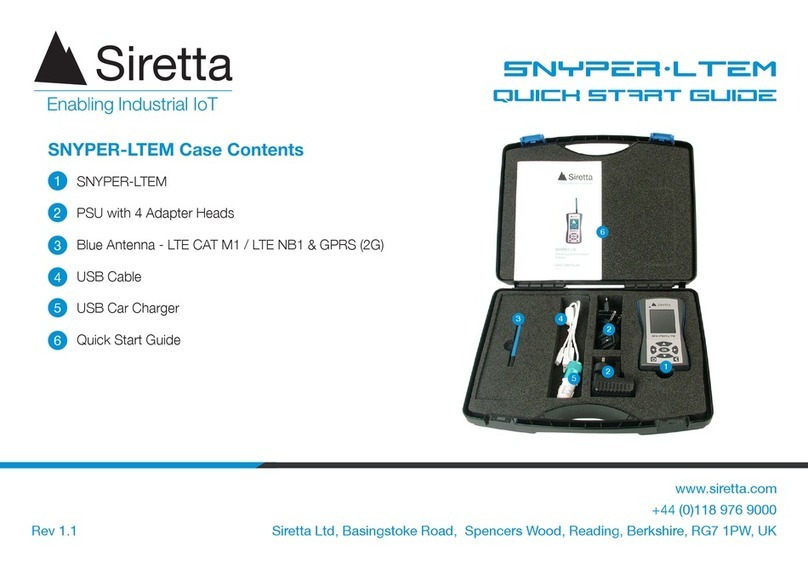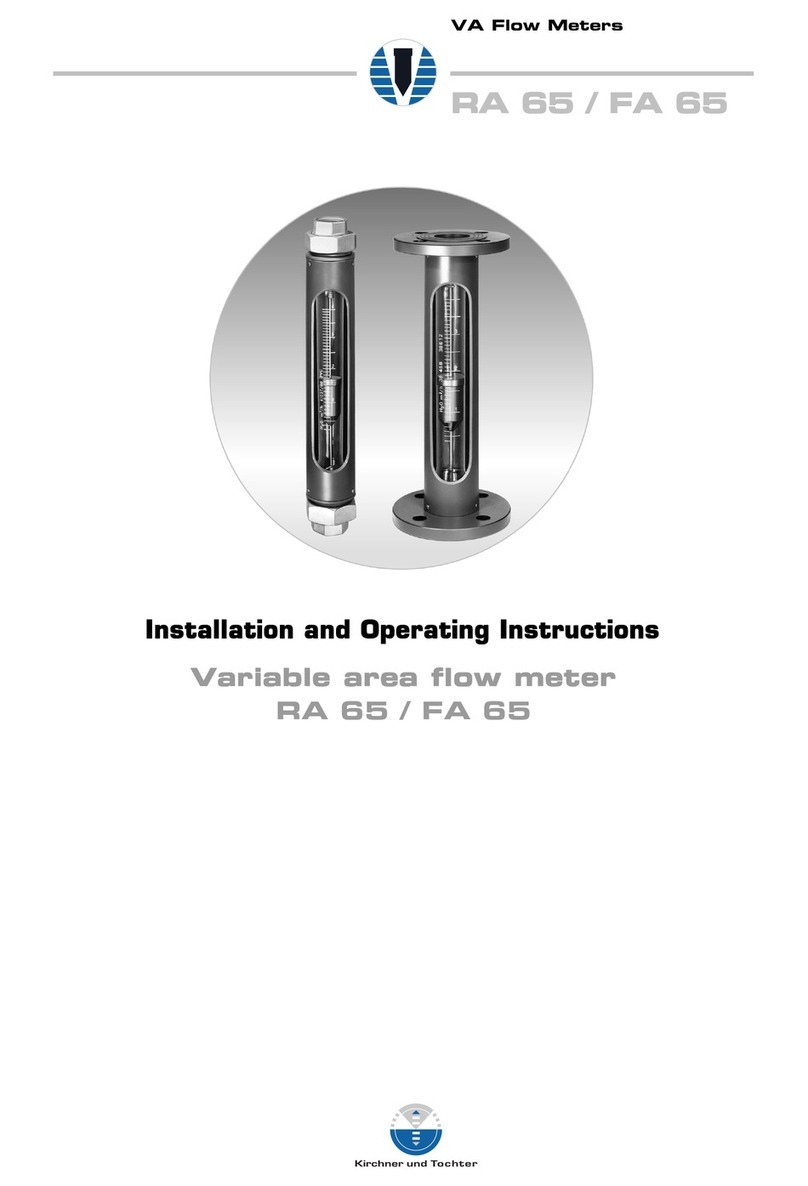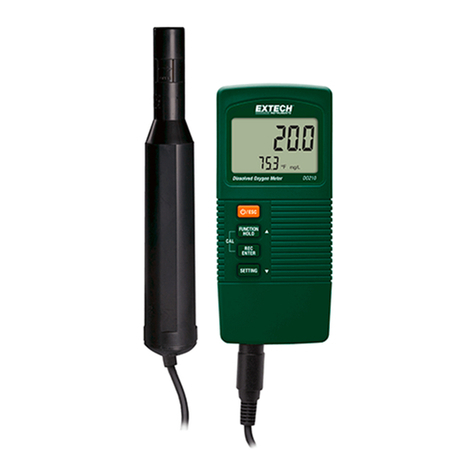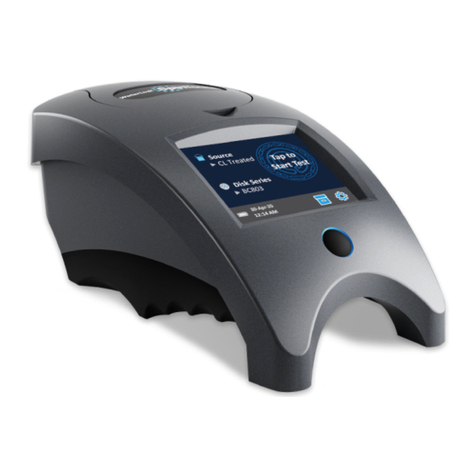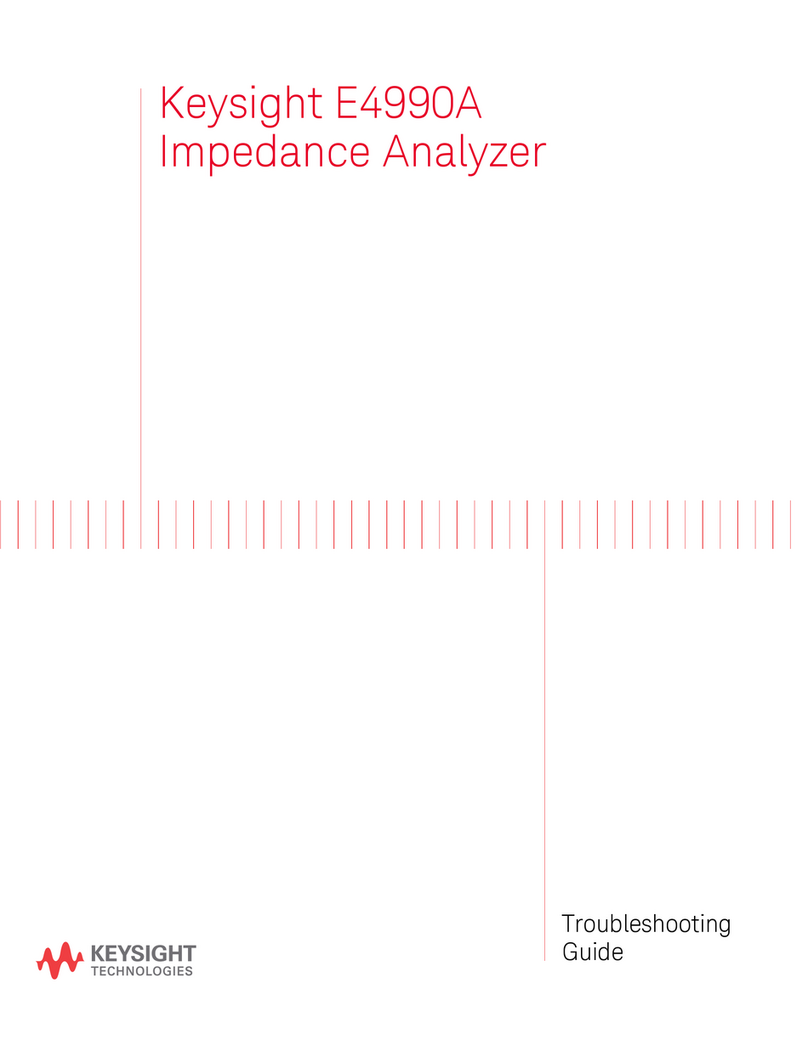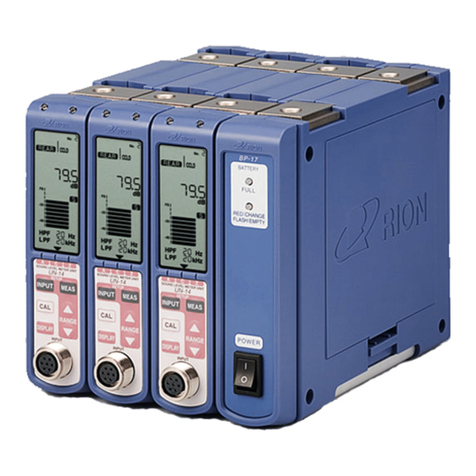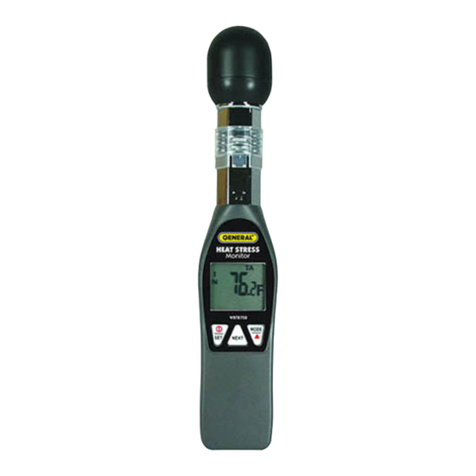BOPP & REUTHER MESSTECHNIK MDS-30 User manual

INSTRUCTION MANUAL
Dosing System MID-MDS
Version LINEARFILLER
Software VER 1.00
Hardware Housing MDS-30/49/84
Terminal connectors QB-173
QB-172
QB-170
Counter / Valve card LS-23
Master card DR-11
Converter card UV-12
Terminal ( Software ) V100
A-EN-05801-00A
Bopp & Reuther Messtechnik GmbH
Am Neuen Rheinhafen 4
D-67346 Speyer
www.bopp-reuther.de

INSTRUCTION MANUAL
Installation and operation of the
MODULAR DOSING SYSTEM SERIES MID- MDS
1.Application:
The Modular Dosing System MID-MDS is used on both linear and rotating filling machines, where high
accuracy/repeatability is required. The products must have a minimum conductivity of approx 1 µS/cm. The
minimum dosing time achieved to date is approx. 0.1 sec.
Magnetic Inductive Flow Meters series MID have no moving parts, and therefore do not apply any "work" to
the product which could cause changes to the fluid structure. This also enables CIP/SIP procedures to be
carried-out both easily and quickly.
2. The dosing system MID-MDS consists of the following components (Fig.1):
- magnetic inductive flow meter series MID
with standard frequency field design, with integral pre-amplifier
- dosing control ( electronics ) series MDS:
* converter card type UV- 12 * master card type DR- 11
with integral pulse output
* counter/valve card type LS- 23 * LAUER operator terminal
* housing for card installation: panel housing type MDS-30 ( 30 TE ), or
panel housing type MDS-49 ( 49 TE ), or
19" rack mounting type MDS-84 ( 84 TE )
1
12
Terminal
LAUER
PC/SPS
12345
6
24 VDC
24 VAC
QB-173
CONVERTER
CONVERTER
CONVERTER
CONVERTER
CONVERTER
meter 6
meter 1
CONVERTER
CARD
UV-12
NAMUR
pulse inputs
cable with plug
cable with plug
CPU parallel input/output port
12 valve power modules dual-port-RAM
COUNTER/VALVE CARD LS-23
electronics MDS-30/49/84
selection of the
counter/valve cards
parallel input/output port
serial 1 serial 2 optocouplers
MASTER CARD DR-11
QB-xxx
Input/Outputs
QB-181 QB-173
pre-and final closing
of the valve
QB-172
QB = Adapter card

storage tank
start signal
valve signal
measuring cable
magnetic
inductive
flow meter
type MID-MDS
dosing valve
receptacle
terminal
type LAUER
elektronics
type MID-MDS
v
t
BC
A
v
t
BC
A
excess volume
finalbatch volume
v= flow velocity ( m/sec )
v
t
BC
A
prebatch volume
finalbatch volume
excess
volume
v= flow velocity ( m/sec )
3. A filling system/installation generally consists of (Fig.2):
Fig.2
Systems with very short dosing times ( min. 0.1 to some sec. ) need a storage ( buffer ) tank-see Fig.2- the
level of which must be kept more or less constant, e.g. by using a level control system, which automatically
opens and closes the feed line to the storage tank. This arrangement supplies a dosing curve ( lapse ) as
shown in (Fig.3):
1- stage valve closing
At time A the filling machine starts the batch process and the
dosing valve opens. The magnetic flow meter measured the
product; the sensed signal is send to the dosing control and also
to the preset counter. At the end of the batch (B) the dosing
valve receives the signal to close. Because of delay time in the
system ( mainly the valve ) a certain excess volume passes the
dosing valve until it is closed and the batch process is finished
(C).
2-stage valve closing
It is possible to decrease the excess volume if a 2-stage valve
closing is used. If the valve receives the prebatch signal ( B ),
then the valve closes to a interposition.
If the valve receives the finalbatch signal ( C ), then the valve
closes completely.
These kind of valve closing should also be used if
- the meter size is > DN 20 or
- the batch is > 0.5 l / sec.
- the velocity in the pipe is > 5 m/sec.

4. The components of a filling system should meet the following requirements:
a) storage tank ( no pressure, head of liquid only )
The tank dimension ( dia.,height ) should be such that a batch process ( one filling ) only causes a very small
level variation ( decrease ). In the event of a large variation, the head ( gravity ) decreases rapidly, the
excess volume is altered ( Fig.4) and both accuracy and reproducibility vary.
v
t
v
t
AB
batch end batch end
excess
volume excess-
volume
dosing time of 1.st filling dosing time of the following filling
start start
A B
Fig.4
Due to the decreasing head of liquid, the flow velocity and the flow rate decrease, resulting in the dosing
time becoming longer and longer ! This effect should be avoided if the dosing time is to be kept constant.
To keep the filling times constant, the liquid level head should be kept within 5% .
At bigger meter sizes (> DN 15) the
liquid level must be more then 30 cm.
If the level < 30 cm, Vortex-effects are
possible and resulting accuracy vary.
( A ).
To prevent vortex effects a build -in
straightener is advantageous.
Very important is the position of the
product line in the tank. The outlet of
the pipe must be under the liquid level (
B ). In other case, air bubbles are in the
product and resulting accuracy vary.
b) piping
Whenever possible rigid metallic piping between storage tank and dosing valve should be installed. If flexible
hoses are used, hydraulic vibrations could disturb the batch processes. The piping should be of the same size
( DN;inner dia. ) as the magnetic inductive flow meter in order that the system can be deaerated easily.

Hydrau
lic vibrations are be created, if e.g.
diaphragm, hoses or buffer tanks are
existing.
The energie in the liquid is decreased
with the oscillation of the liquid.
If the velocity cross the creeping flow
( B ), the pulse output in the converter
card is switched off.
If a new start pulse is comming during
oscillation, the velocity in the pipe
increased ( C ).
A B
C
start
valve closes
creeping flow
start
If hoses are used, then the hoses must be metal cased.
c) dosing valve
The dosing valve is very important for the accuracy/reproducibility of the dosing system.
Attention should be paid to the following parameters:
c1) closing time: the closing time of the valve has to be in a certain ratio to the dosing
time ( A to B ); the shorter the dosing time the shorter the valve closing time.
Guideline:
<<< the valve closing time should be not more than 10% of the dosing time >>>
If it is more than 10%, the dosing control is only able to register the size of the excess volume, but will not be
able to react to it ( i.e. compensate/correct it for the next filling ). This effect can only be avoided by using a
two-stage shut-off ( two valves ), where the 2.nd ( final ) stage can compensate/correct alterations of the 1.st
( pre- ) stage.
c2) power supply: whenever possible a DC supply should be used to avoid the influence of the shape of
sine waves of the AC supply. This is especially if the valve closes with voltage; the valve starts to close
when the sine wave has exceeded the starting voltage; in the worst case this can take 10 ms ( 50 Hz field )
and so cause variations of the batched quantity ( in accuracies ).
c3) dosing valve: it is important that only a small volume is
displaced during the closing procedure. The displaced volume
is part of the measured quantity and thus influences the
accuracy and reproducibility of the complete dosing system. It
should therefore be kept as constant as possible! An instability
of the displaced volume can effect the accuracy of systems
where small quantities are dosed. Diaphragm valves with
metallic body are recommended, where a diaphragm of a
synthetic material ( plastic ) is oppressed onto a metallic edge.
This design has another positive effect: fruit particles and
similar solids to be dosed are squeezed off the valve seat.
Diaphragm valve type 625 ( GEMÜ )

5. Description of the components
a) magnetic inductive flow meter series MID has an integrated and detachable pre-ampifier. The coils for the
magnetic field requires a 24 VAC power supply.the cable for interconnection of the meter and the converter card is
approx. 5 m long ( if a length of more than 5 m is required ( max. 200 m ), an extension cable of same type is
admissible ). In the event of a malfunction the pre-amplifier can be detached and replaced; no calibration of the
replacement is required! The pre-amplifier is connected via plug and socket. The meter can be installed either
horizontally or vertically. Vertical installation is preferred for better deaeration; and also depositsare less likely to be
trapped in the meter. In the case of horizontal installation the electrodes must be in horizontal position, i.e. the
pre-amplifier must be above or underneath-but not beside- the meter body. If the meter is used together with a
converter card UV-12 the flow direction ( right to left/left to right or from below to above or vice versa ) of the meter
is insignificant. The UV-12 switches automatically to the given flow direction and measurement can be started
immediately.
Cables for power and signales
It´s not allowed to install the meter or the electronik in an area with strong magnetic fields. The Measuring cable
must be install separatly from cables with power or controlsignals. The best solution is the installation for the
measuring cable in a grounded pipe of metal.
A
B
C
D
E
Note : Other connectors on request

colour signal voltage core
white measurement 0-50 mVAC
+/- 2 VDC
shielded
brown reference voltage 2 hasta 4 VAC shielded
yellow
green
power supply for
pre-amplifier
+ 15 VDC
- 15 VDC
unshielded
red and blue power supply for
the coils
24 VAC unshielded
Dimension of flow meter with sanitary connectors DIN 405
Note : Other connectors on request
Measuring cable
The measuring cable is a standard cable to DIN series LIYY- LIYCY) with two shielded and four unshielded
diameter connector A B C D Eactual power current weight
DN mm mm mm mm mm WAkg
-----------------------------------------------------------------------------------------------------------------------------------------------------
40 2" 120 190 80 75 185 5 0,4 7,5
diameter connector A B C D Eactual power current weight
DN DIN 405 mm mm mm mm mm WAkg
------------------------------------------------------------------------------------------------------------------------------------------------------
10 RD 28x1/8 80 150 60 60 155 4 0,3 3,5
15 RD 34x1/8 80 150 60 60 155 4 0,3 3,5
20 RD 44x1/6 80 150 60 60 155 4 0,3 3,5
25 RD 52x1/6 120 190 80 75 185 5 0,4 7,5
diameter connector A B C D Eactual power current weight
DN DIN 405 mm mm mm mm mm WAkg
-----------------------------------------------------------------------------------------------------------------------------------------------------
10/12 RD 27x1/10 80 150 60 60 155 4 0,3 3,5
Dimension of flow meter with steril connectors NAUE (ISO)
Dimension of flow meter with TRI CLAMP ISO 2852
Fuses for the meter ( mounted onto the terminal adapter QB-173)
------------------------------------------------------------------------------
meter size 24 VAC
-----------------------------------------------------------------------------
DN 10 0.4 A
DN 15 0.4 A
DN 20 0.4 A
DN 25 0.6 A
DN 40 0.6 A
-----------------------------------------------------------------------
Quick-operating fuses must not be used

Installation guideline for transmitter
Inlet/Outlet
For a optimum flow profile it must be installed flow straightener behind and in front of the meter.This can be be
realized. with straight pipes in the upstream- and downstream pipework.
The upstream pipework must be 5 x DN and the downstream pipework must be 3 x DN. It´s not allowed to install
any kind of devices upstreames. It´s forbitten to install in front of the upstream pipework devices which produced
effects like spin or vortex, e.g. space bend, butterfly valves or slider. Any regulation devices must be installed
behind the meter.
Inclinations must be rotational symetrical and the angle should be < 8 °.
The upstream-,downstream pipework and the meter must have the same diameter !!
Length of the upstream-and downstream
pipework for the meter ( mm ) :
DN upstream downstream
10 50 30
15 75 45
20 100 60
25 125 75
32 160 100
40 200 120
Ground connection for the transmitter
The transmitter don´t need additional ground connections. Since the transmitter use the pipe potential as
reference, the upstream-and downstream pipe must be on ground.
The installation of the meter in plastic pipes is not allowed.
The power supply 24 VAC should be also on ground.
Mounting position of the transmitter
It must be insure, that the meter tube is allways completely filled during measuring and is protected against
asymetric formation of deposits. The vertical position is preverred, since it is simple to make the pipe airfree.
Is the meter is installed horizontal, then it must be insure, that
the electrode axis is also horizontal.
Pipework must be supported adjacent to the meter and
connections and provide 3° slope for draining..
If the electrode axis is vertikal, then air bubbles can be isolate
the electrical connection between the electrodes and the
product.
In this case the output signal is undeclared
Laying of the measuring cable
It´s forbitten to install the meter in areas with strong magnetic fields. The measuring cable must be lay separately
from power cables and control cables.
To lay the measuring cable in grounded metal pipes is recommended. Measuring cables can be routed together
with other measuring cables.
D
flow direction
5D upstream pipework 3D downstream
pipework
Electrode axis

Installation guideline for the electronics
General:
It is forbitten to install the electronics in areas with strong magnetic fields. The wiring must be depending from the
function of the cables :
cables for signals e.g. start, error
cables for control e.g. cable for control the diaphragm valves
cables for measuring e.g. measuring cable between the meter and teh electronics
cables for power e.g. 24 VDC, 24 VAC , power for motors
Cables for signals or cables for control can be routed together to a multiple cable.
Measuring cable must be routed with the same cable typ. It is not allowed to bring together several measuring
cables to one shielded cable .
If it is necessary to lengthen the measuring cable, then the terminals for the measuring cable must be separate
from terminals with power. In general the same prinziple as for the cable is valid: the terminals must also be
separate depending from their function.
Heat development
The produced energie from the electronics must be undisturbed left the housing. It must be insure, that air
circulation is possible. All about the housing ( excluding the front plate ) must be a distance of min. 10 cm to other
objects. To take off any cable on the top of the housing is not permissible.
If several housings are installed, then the same principle is valid.
If fans are used, the distance can be reduced.
One fan is necessary for two housings. The width of the fan
module should be the width of the housing.
If the fan is only installed for air circulation, then it is important to
know, that the temperature in the housing can be increased.
If the inside air is exchanged with the air outside of the housing,
then a dry air is necessary.
For air circulation with the outside air please ask a manufacturer
about special components for installation in a panel cabinet.
Power supply
The installation of the cable for power supply 24 VDC/ 24 VAC must be laid star-shaped to each terminal
connector card QB 172 ( see B 407.4-11 D page 1 ).
Note : The dimension of the wire cross section for 24 VDC must be considering also the current for the
solenoid valves
10 cm
10 cm
10 cm
10 cm
Installation of 2 panel housings in a cabinet

Technical data
Transmitter
General
Nominal diameter :DN 10, 15, 20, 25, 32, 40
Pressure max. in bar : Sanitary connector PN 10
Steril connector PN 16
Tri-Clamp PN 16
NEUMO flanges PN 16
Minimum Conductivity : 1µS/cm
Mounting position : vertical, if horizontal cannot be avoided, then the electrodes must be in
horizontal position. The pipe must be completely filled with product.
Mounting length : DN 10 to 20 : 150 mm
DN 25 to 40 : 200 mm
Measuring cable lenght : max. 250 m
Any extension of the cable built onto the transmitter is possible, but it must
be of same type.
Type of measuring cable : LIYY- LIYCY
Material
Metering tube : 1.4571
Process connections : 1.4571
Lining : PTFE
Electrodes : Hastelloy C22
Housing : Preamplifier : Cast aluminium, plastic coated
Housing : Polyurethane
Temperature/Humidity
Liquid temperature max. : 140 °C
Ambient temperature max. : 70 °C
Ambient humidity : < 75% on average, dew-formation permissible
Protection class : IP 67 according to EN 60 529
Power supply
Voltage : 24 V ± 10 % sine wave
Frequency : 50 Hz ±5% or 60 Hz ±5%
Distortion factor : max 1%
Other connectors on request

Technical data
Electronics
General
Housings : - Panel mounting or
- 19" rack
Protection class : panel housing
front : IP 65 acc. to EN 60 529
connection : IP 20 acc. to EN 60 529
: 19" rack : IP 20 acc. to EN 60529
Power supply : 18 VDC to 36 VDC
Ripple : < 1%
Power consumption : depending on number of cards
Ambient temperature max. : 50 °C
Ambient humidity max. : mean < 50%, dew-formation not permissible
Converter card UV-12
Input : Measuring voltage and reference voltage from transmitter
Measuring range : 10 m/s standard
2.5 m/s option
Output : 0 to 50 kHz proportional to velocity in the pipe
( other frequencies on request )
see documentation UV-12
Counter/Valve card LS-23
Input : Frequency from converter card UV-12
Pulses from NAMUR-card QB- 181 ( option )
Output : valve driver for control of solenoid valves
max. voltage : 36 VDC
max. current : 0.5 A
Master card DR-11
Inputs from QB-xxx : 24 VDC ± 15%
High-level : > 10 VDC
Low-level : < 5VDC
Input resistance : 2.4 kOhm
Outputs to QB-xxx : 18 VDC to 36 VDC
Output current max. : 10 mA

Error Limits
Reference conditions according DIN 19200 and VDI / VDE 2641
Fluid : water ( free of gas )
Liquid temperature : + 25 °C ± 2 K
Ambient temperature : + 22 °C ± 2 K
Warm-up time : 30 min.
Installation acc. : up-stream section > 10 DN
reference conditions : down-stream section > 5 DN
Error limits according reference conditons
Power supply for transmitter : 24 V ± 10 %
Frequency : 50 Hz ±5% and 60 Hz ±5% respectively
Power supply for electronics : 18 V to 36 V DC
Ripple : < 1%
Pulse output : ± 0.5 % of measured value plus ± 0.01% FS
: FS = 50 kHz at 10 m/s
Repeatability : ± 0.1 % of measured value plus ± 0.005 % FS
Build-up time : 50 ms ( 10 % to 90 % FS )
Temperature drift during
warm-up time = 30 min. : ±1% of measured value plus ± 0.1 % FS
Temperature influence on
Transmitter and electronics : ± 0.1 % / 10 degr. C

6. Requirements for commissioning:
a) the meter must be correctly installed
b) the pipe must be completely filled with product
c) the power supply for meters and dosing control must be switched on
d) the flow velocity must be absolutely zero:
before starting the dosing/filling machine a zero point setting must be carried out;
this is done by pressing key F7 and F2: the zero point procedure is carried out commonly for
all converter cards/meters connected to the system. Upon successful completion, the green
LED´s on the front panal of the MDS-30; MDS-49 and BGT-84 are off. If not refer to
chapter 7., fault finding !
e) the start release unit of the filling machine must be connected:
This is connected to the start input of the master card DR-11 via its terminal adapter;
a 24 VDC pulses of at least 10 ms is necessary.
To check the operation ( follow-up the dosing procedure ) the operator terminal should be in
position F6 ! If there are any problems refer to chapter 7.,fault finding.
7. Fault finding
a) zero point setting is not possible:
assumptions: pipe is completely filled with liquid,
power supply is switched on
a1) power supply of the meter via the 3 LED´s of the terminal adapter card QB-173:
24 VAC for the meter coils
Upper LED is off check if 24 VAC is present
check fuses on terminal adapter QB-173
+ 15 VDC of converter card and pre- amplifier
centre LED is off check if 24 VDC is present
fault of converter card: replace!
- 15 VDC of converter card and pre.amplifier
Lower LED is off check if 24 VDC is present
fault of converter card : replace!
a2) reference voltage:
assumption: 24 VAC is present ( upper LED is on )
prüfen: measure the reference voltage between the
brown wire and the shield ( terminal adapter
QB-173 ); it should be 2,5 to 3,5 VAC!
if this voltage cannot be received:
check reference cable ( brown wire and shield )
on cable break or short-circuit
if reference cable is o.k.:
replace meter ( meter defect )

a3) set of automatic zero point :
for checking the function of the zero point setting circuitry ( part of
the converter card UV-12 ) the white wire must be removed from
the terminal. Then install a short connection between both
terminals from the white wire and the shield on QB-173.
Now press key F7 of the operator terminal and after F2
( for " yes" ).
zero point setting successfull ? ( "Yes" means : green LED is off)
if "no" : replace converter card
if "yes" : replace meter
a4) oscillation zero point:
check:
- the whole system ( piping, meter, valve) must completely be filled with
product and free of gas
- are the valves closed?
- the conductivity of the product must be > 1 µS/cm
- the flow velocity must be > 0.25 m/sec
v (m/sec) = ( Q x 1.273,2 ) : DN2
Q (l/sec) = ( v x DN2 ) : 1.273,2
b) alternating/oscillating batch quantities:
b1) alternating/oscillating actual quantities( volume/weight of the
receptacle):
check:
- does the liquid level of the tank decrease filling by filling by more than
5% of its previous value? The excess volume may differ from filling to
filling.
Refer to chapter 4, section a)!
- if the dosing time is < 0.5 sec the closing time of the valve influences
the accuracy of the batch volume. The closing time of the valve must
not excess 10% of the dosing time.
Refer to chapter 4., section c)c1)!
b2) altern./oscill. counter quantities ( see operator terminal key F6):
- if the real/true quantities ( appearing in the display ) differ by not more
than +/- 1ml compared with the set quantities, but the contents of the
receptacles do ( i.e. show bigger differences compared to the set
quantities ) then the valve outlet is dripping ( varying from filling to
filling ) When the valve closes the product must cease lowing instantly!
Check design/construction of the valve outlet !

c) Function of LED on Master card DR-11 and Counter/Valve card LS-23
These cards have 2 LED in front
red CPU
This LED is ON, if the CPU in the system stand still. In this case, the
system is automatically restarted.
Check following, If this is not sucessfull :
a) EPROM installed ?
b) CPU or EPROM correct installed in the socket ?
c) Quartz for CPU --> OK
If a) to c) --> OK, change card
yellow no function for dosíng application
This LED is used for showing information for our serviceman. Several
software version used this LED for indication e.g. the startinput.

Electronics MDS-30 / 49 / 84
MDS 30 MDS 49
LS-23/1
DR-11
LS-23/1
LS-23/2
DR-11
LS-23/1
UV-12 / 1
UV-12 / 2
UV-12 / 3
UV-12 / 4
UV-12 / 5
UV-12 / 6
UV-12 / 1
UV-12 / 2
UV-12 / 3
UV-12 / 4
UV-12 / 5
UV-12 / 6
UV-12 / 7
UV-12 / 8
UV-12 / 9
UV-12 / 10
UV-12 / 11
UV-12 / 12
LS-23/1
LS-23/2
LS-23/3
DR-11
MDS 84
UV-12 / 1
UV-12 / 2
UV-12 / 3
UV-12 / 4
UV-12 / 5
UV-12 / 6
UV-12 / 7
UV-12 / 8
UV-12 / 9
UV-12 /10
UV-12 /11
UV-12 /12
UV-12 /13
UV-12 /14
UV-12 /15
UV-12 /16
UV-12 /17
UV-12 /18
Installation of the units in the housing
The elektronics is available in 3 different housings:
- MDS-30 for max. 6 channels
- MDS-49 for max. 12 channels
- MDS-84 for max. 18 channels
Max. built-in units:
MDS-30 MDS-49 MDS-84
converter card 6 12 18
counter/valve card 1 2 3
master card 1 1 1

MDS 30 MDS 49
MDS 84
QB-181
QB-172
QB-xxx
QB-xxx
QB-181/2
QB-172/2
QB-181/1
QB-172/1
QB-173 / 1
QB-173 / 2
QB-173 / 3
QB-173 / 4
QB-173 / 5
QB-173 / 6
QB-173 / 7
QB-173 / 8
QB-173 / 9
QB-173 / 10
QB-173 / 11
QB-173 / 12
QB-173 / 1
QB-173 / 2
QB-173 / 3
QB-173 / 4
QB-173 / 5
QB-173 / 6
QB-173 / 1
QB-173 / 2
QB-173 / 3
QB-173 / 4
QB-173 / 5
QB-173 / 6
QB-173 / 7
QB-173 / 8
QB-173 / 9
QB-173 / 10
QB-173 / 11
QB-173 / 12
QB-173 / 13
QB-173 / 14
QB-173 / 15
QB-173 / 16
QB-173 / 17
QB-173 / 18
QB-181/1
QB-172/1
QB-181/2
QB-172/2
QB-181/3
QB-172/3
QB-xxx
Installation of the terminal connector cards in the housing
View on the
units
component side View on the
terminal connector
card

240
35
144
A
A
MDS-30 MDS-49
192 288
Dimension MDS- 30/49
terminal connector card front screw
Current consumption depending of the number of units ( only 24 VDC )
1 2 3 4 5 6
MDS 30 0,2A 0,3A 0,4 0,5A 0,6A 0,7A
7 8 9 10 11 12
MDS 49 0,85A 0,95A 1,05A 1,15A 1,25A 1,35A
13 14 15 16 17 18
MDS 84 1,5A 1,6A 1,7A 1,8A 1,9A 2A
240
57133
A
B
A
MDS-49 MDS-84
287 465
B305 483
Dimension MDS- 49 / 84

<<<<<< ATTENTION - ATTENTION - ATTENTION - ATTENTION <<<<<<
How to take action
1. before first commissioning, and
2. when replacing components.
--------------------------------------------------------------------------------------------------------------------------------------------------
1. before first commissioning
a. Activate batteries on cards DR- 11 and LS- 23:
The built- on batteries will store the set data in case of power failure.
Batteries on cards supplied from stock are
de- activated to avoid discharge during storage.
To activate the batteries the jumpers must be brought in position " ON ".
For jumper position see following drawings:
- card DR- 11: draw. No. 2- 81- 14816.4
- card LS- 23: draw. No. 2- 81- 14821.4.
b. Set (key- in) system data into the LAUER terminal:
For correct function of the dosing system the following data must be set:
F1 number of dosing lines e. g. 1
F2 size (DN) of flowmeter e. g. 10 mm
F3 batch quantity e. g. 100 ml
F5 max. permissible dosing time e. g. 1000 ms
c. When using a PLC (instead of a LAUER terminal):
All telegrams, containing the system data, must be sent to the dosing system.
d. Fill dosing line with liquid.
e. Set zero point by pressing key F7.
Now the dosing system is ready for operation!
--------------------------------------------------------------------------------------------------------------------------------------------------
2. when replacing components
If a card DR- 11 (or LS- 23) must be replaced by a new one, first activate the
battery on the new card by bringing the jumper in position " ON "; see above!
If the dosing system contains further cards DR- 11 (or LS- 23), which must not
be replaced, pull their battery jumpers and bring them back to position " ON ".
Replacement of cards only when power supply had been switched- off!
So, all stored system data are erased!
Key- in system data as described above.

Batterie
OFF ON
Reset ( not change !!! )
LS-23
Batterie
OFF ON
DR-11
Adjustment from the batterie jumper
This manual suits for next models
2
Table of contents
Other BOPP & REUTHER MESSTECHNIK Measuring Instrument manuals
